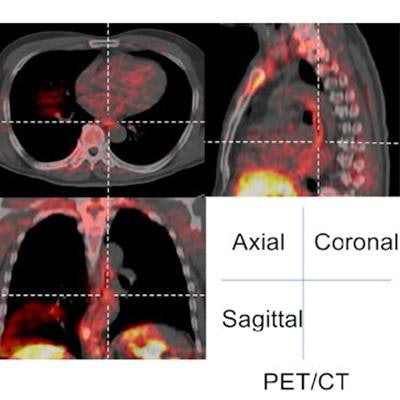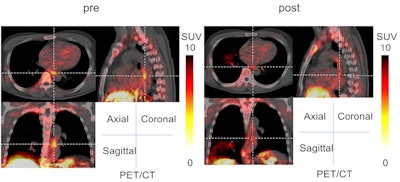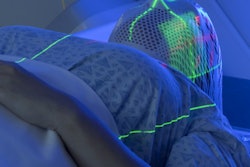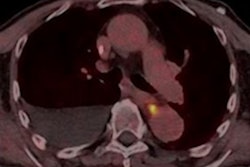
PET/CT imaging with carbon-11 methionine (MET) appears promising for detecting early patient response to neoadjuvant carbon ion radiotherapy (CIRT), according to a study published August 11 in Scientific Reports.
Japanese researchers investigated whether MET radiotracer uptake in PET/CT imaging could determine if esophageal cancer patients were responding to CIRT, an emerging type of particle radiation treatment. They found MET uptake clearly decreased in response to treatment, which could be useful for identifying patients who may not need to undergo surgery.
"The advantage of avoiding surgery after radiotherapy is of paramount importance," wrote corresponding author Dr. Ryuichi Nishii, chief of diagnostic nuclear medicine at the National Institutes for Quantum Science and Technology (QST Hospital) in Chiba, and colleagues.
Neoadjuvant radiotherapy is an initial treatment used to shrink tumors, with PET/CT imaging providing insight on whether the approach is working well enough for patients to avoid surgery. CIRT is an emerging type of neoadjuvant treatment that uses charged ions rather than x-rays to destroy cancer cells, and it delivers less radiation and damage to surrounding tissue, according to the authors.
The first heavy ion accelerator in the world enabling CIRT was installed at the group's institution (formerly the National Institute of Radiologic Sciences) in 1994. Since then, they have treated more than 20,000 patients using the approach.
Moreover, while PET/CT with the FDG radiotracer has proven effective for imaging these patients, MET is considered a more accurate tracer, and in this study, the researchers aimed to investigate how effective it is for detecting CIRT response in patients with esophageal cancer.
They analyzed imaging of 19 patients (14 men and 5 women; median age 63 [47-80] years) with proven thoracic esophageal squamous cell carcinoma who underwent MET-PET/CT scans before and three weeks after the completion of CIRT.
The maximum and mean standardized uptake values (SUVmax and SUVmean) were used to assess MET radiotracer uptake by the tumors. In CIRT of esophageal cancer, MET uptake clearly decreased in response to treatment, the researchers wrote. Specifically, pre-CIRT SUVmax across all patients was 8.29 compared with a post-CIRT SUVmax of 6.41 (p < 0.005), while SUVmean prior to CIRT was 5.01 and 3.94 after CIRT (p < 0.005), according to the results.
"MET PET/CT is clinically useful for the assessment of early response to neoadjuvant CIRT in esophageal cancer. Particularly, post-SUVmax is considered a promising PET imaging parameter," the authors wrote.
 A grade 3 case (T1bN0M0, stage I) of esophageal cancer showing carbon-11 methionine radiotracer uptake on PET/CT before and three weeks after carbon ion radiotherapy. Image courtesy of Scientific Reports.
A grade 3 case (T1bN0M0, stage I) of esophageal cancer showing carbon-11 methionine radiotracer uptake on PET/CT before and three weeks after carbon ion radiotherapy. Image courtesy of Scientific Reports.The study is the first to report MET-PET/CT imaging in esophageal cancer patients and to evaluate radiotracer uptake as a parameter for detecting early response to CIRT, according to Nishii and colleagues. As such, limits included the small number of patients, they wrote.
Ultimately, the researchers suggest CIRT offers an alternative to conventional radiotherapy, given that it delivers less radiation to patients, and that MET-PET/CT imaging will play a key role in determining how well patients respond to the treatment.
"We are planning to determine clear indication criteria of CIRT for esophageal cancer by a combination of MET-PET with other important prognostic factors," they concluded.



















